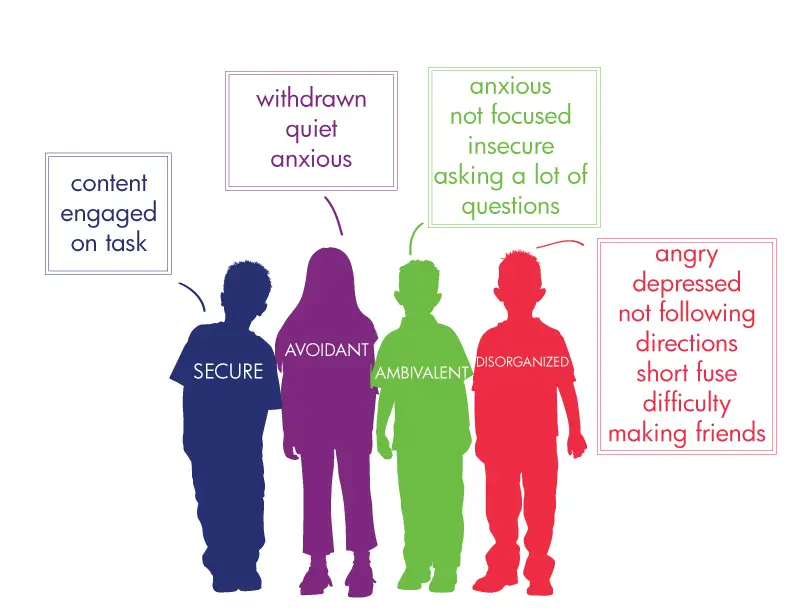What if we told you that we already know the single greatest predictor of how well a child will do in life – regardless of what we’re measuring him on? That’s incredible, right? Well, guess what. We do. It’s called attachment.
Attachment is the basic framework for understanding human connection. That is, how well a person is connected to others. Early connections establish a pattern for later connections in life. That’s why our earliest connections, the connections between a baby and her caretakers/parents/adults are so important. What does this all look like?
Psychologist Mary Ainsworth identified three major types of attachment through her research: secure attachment, ambivalent-insecure attachment, and avoidant-insecure attachment. In later research, Main and Solomon added a fourth attachment style called disorganized-insecure attachment. Let’s take a look at these four styles of attachment.
Secure Attachment
A child with secure attachment has, you guessed it, a sense of security in the world. This child has parents who consistently meet her needs. She knows that she is cared for and loved. If she cries, a parent will come. If she’s hungry, she will be fed. If a parent leaves, he or she will return again.
It’s really important to mention that no parent gets this right 100% of the time. In fact, a parent can get it right about 40% of the time and still develop a secure attachment. That’s a relief, right? But the key differentiator here is that parents make every effort to repair any emotional damage or infractions, through an apology and a sincere effort to do better when things don’t go well. So it’s okay to mess up, but it’s important to repair. Parents and caretakers who are attuned to their child and show security and love can develop a secure attachment.
Ambivalent-Insecure Attachment
On the opposite end of the spectrum is what is commonly referred to as insecure attachment. Ambivalent-Insecure Attachment occurs when a parent is inconsistent in caring for the needs of the child. For example, this might be a parent who takes care of a crying baby one time, but the next time she cries, the parent ignores her. This is confusing for a young child or baby. She is now left wondering in her internal world, “If I cry, will someone take care of me?” or “Sometimes dad loves me, and sometimes he doesn’t.” As a result, being raised with this type of attachment can cause a child to act disinterested or ambivalent toward the caretaker as a way to mask the distress she might feel when she is confused or left alone. This ambivalence can keep the child from forming strong, positive emotional connections with her caretaker. Children with Ambivalent-Insecure Attachment are often highly anxious.
Avoidant-Insecure Attachment
Children who develop Avoidant-Insecure Attachment often have their needs minimized or not responded to at all. This might look like a parent responding to a crying child with, “You’re fine. Get up. Stop whining like a baby.” It might be a child showing her mom something she made at school, and mom telling her to leave her alone because she’s too busy. This dismissive style of parenting is damaging to young children who rely on their parents for not only physical needs, but also emotional needs. A child growing up in this environment might interpret this response as devaluing them as a person and might not continue to try connecting emotionally with other people. Children with Avoidant-Insecure Attachment are those who turn inward. They are often the quiet children who fly under the radar.
Disorganized-Insecure Attachment
This is truly the most damaging of the three insecure attachment styles, and is a result of highly unpredictable parenting. Children with a Disorganized-Insecure Attachment style often live with a parent who is terrified, terrifying or both. If a child is crying, a parent might yell, “Why are you crying?!” Sometimes a parent may minimize behavior and other times might blow up about a child’s behavior. Children who live in homes with domestic violence often have a disorganized attachment – children in this situation are often afraid to be at home. Unfortunately, with no intervention, children who have this type of attachment style can face lifelong negative consequences. Children with Disorganized-Insecure Attachment are often the “out of control” kids. They have a hard time self-regulating and turn their pain outwards – towards others.

But there’s good news, too! All it takes is a secure attachment with one caring adult to make the difference in a child’s life. So if a child grows up in a home with an insecure attachment to her caretaker, she can form a secure attachment with a grandparent, teacher, neighbor, family friend, or other, caring, trustworthy adult.
A solid understanding of attachment can help those who work with children better understand where the child is coming from and why she behaves the way she does. This perspective can help adults understand the powerful impact of relationships on helping children develop.
We will be diving more into attachment on our blog in the next few weeks. We’ll talk about identifying our own attachment styles, about how each of these attachment types look in children, about how to repair and maintain secure attachment through separation, and more. Stay tuned!
Share with
Related Resources